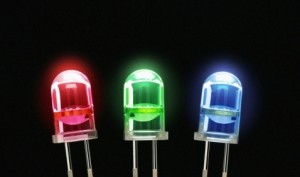Shuji Nakamura, Isamu Akasaki, and Hiroshi Amano were awarded the 2014 Nobel Prize in physics for their invention of blue LED. This enormous achievement begs the question: What makes blue LED more special than its red and green predecessors?

LEDs, or light-emitting diodes, produce light by passing electricity through a semiconductor. A semiconductor contains three regions—a valence band, a conduction band, and a band gap separating the two. Light is emitted as electrons pass from the valence band to the conduction band, and the color of light depends on the size of the band gap.
The semiconductor used in red and green LEDs is gallium phosphide, while the one with the necessary band gap for blue light is gallium nitride. Scientists were aware of gallium nitride’s possible applications as a light source, but before the 1970s, they had yet to develop efficient crystal-growing techniques that would yield a compound without impurities. Nakamura, Akasaki, and Amano developed the essential techniques, enhancing the methods of gallium nitrite production. In doing so, they made blue LED possible.

The winners of the 2014 Nobel Prize in physics were most excited about blue LED’s consequent impact. LEDs have a longer lifespan, emit less heat, and use less electricity than both incandescent and compact fluorescent light sources. The invention of blue LEDs meant that blue, red, and green could all be combined to produce white LED light, which can function as an alternative energy-saving light source. Currently, between 20 and 30 percent of all electrical energy consumed goes toward lighting. The efficacy of LED light could substantially reduce this amount.
